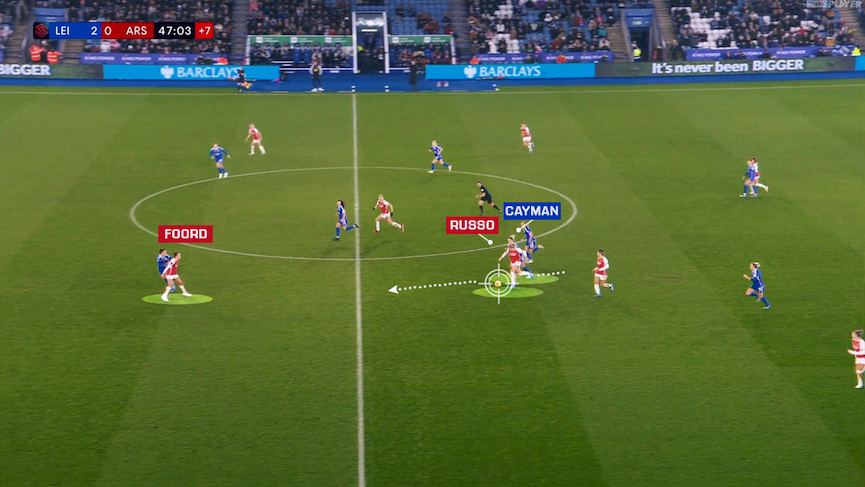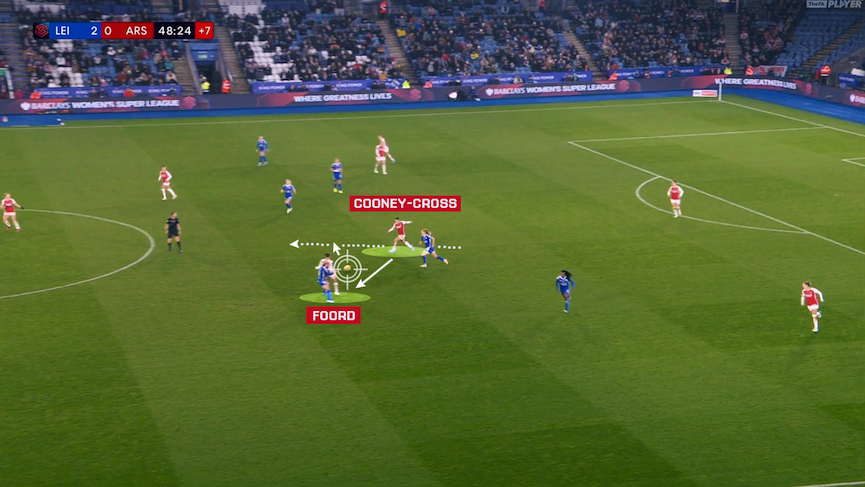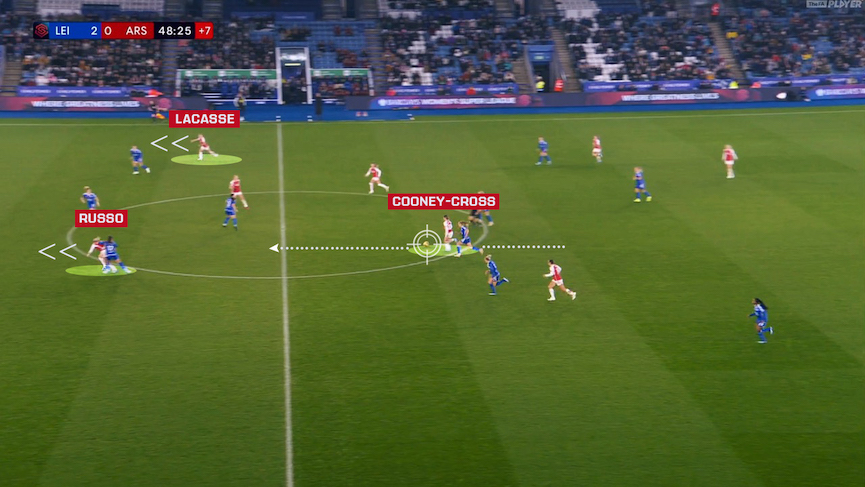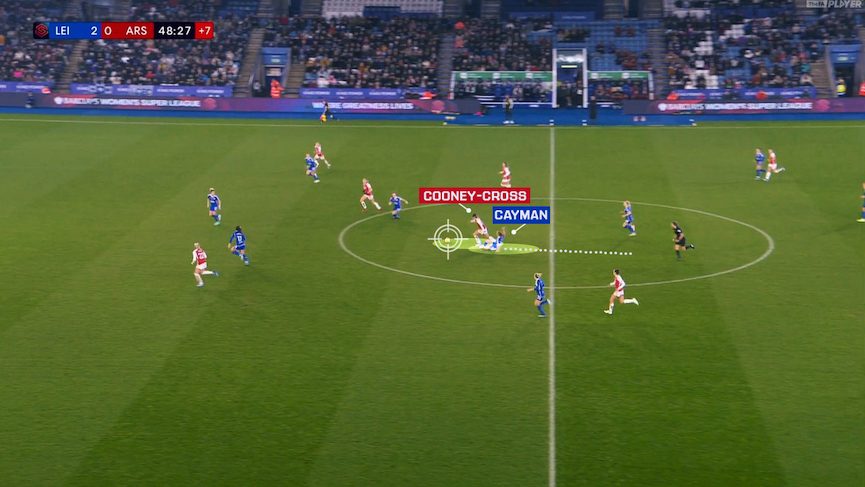Arsenal found themselves 2-0 down at half-time against Leicester City on Sunday evening. Jonas Eidevall told Arseblog News after the game that his team did not change their game plan for the second half, rather, they challenged themselves to do it better. “We kept the structure but we challenged the application on what we needed to do, we did like we usually do, we looked at the clips and looked at how it looks and see where are the spaces.
“Sometimes you get a different experience, both as a coach and as a player. You might perceive that there is not a lot of space and you might need to see that, no, there is a lot of space and we spoke about it. Once I know there is I can trust that.” In the second half, the Gunners scored six with four scored in 12 minutes. At half-time, I sent the tweet below. We didn’t see Blackstenius straight away but I was convinced Leicester’s defence was there for the taking, let’s look at some examples of opportunities Arsenal didn’t take to exploit Leicester’s defensive line.
Certain we’ll see Blackstenius on at half time. Obvs when chasing a game another striker makes sense but Arsenal could really do with another outlet in the channels. Leicester far less comfortable running back towards their own goal but it’s not happened enough in this half.
— Tim Stillman (@Stillmanator) November 12, 2023

Ilestedt clears this cross and the ball runs to Russo on the corner of the box. We can see on the left side that Lacasse and Foord are breaking into space. Pelova is also breaking towards the wide right touchline.

Russo plays the ball down the touchline to Pelova but the ball is played to feet rather than into space and this really suited Leicester’s player-for-player marking system.

Pelova has to slow up her run and go back towards her own goal. The camera angle doesn’t do this full justice but the pass from Russo needs a lot more length on it and to be played into space for Pelova to run into. There is maybe a question as to whether Russo should be on the edge of her own box in open play. Arsenal got that memo in the second half.

McCabe receives the ball here and Foord is signalling for a pass in behind. It’s not an easy pass, but there is space there.

Instead, McCabe checks and passes back to Ilestedt. Not a criminal decision but an example of Arsenal being a little more conservative in the first half.

Pelova does brilliantly to wriggle away from Courtney Nevin and now Russo is well-poised for a run in behind.

But the resulting pass is played behind Russo and she needs to adjust her stride to collect it. You can also see Maanum and Foord breaking into space but Arsenal can’t take advantage because they prized playing to feet over playing into space. Thibaud is able to dispossess Russo here.
Compare to the second half when Pelova plays this through ball to Hurtig in the second half.
That ball through from Pelova 👀#BarclaysWSL @ArsenalWFC pic.twitter.com/3gmOuElZwm
— Barclays Women’s Super League (@BarclaysWSL) November 12, 2023

This is a better example of Arsenal exploiting a Leicester vulnerability. A player-for-player marking scheme is more vulnerable to switches of play and here, Lacasse collects a throw-in, cuts in field and plays the ball to Foord. In the end, Foord’s shot is deflected narrowly over the bar. Foord does something very similar for the first goal to tee up Lacasse.
Cool as you like from @cloe_lacasse! 🧊#BarclaysWSL @ArsenalWFC pic.twitter.com/kiyfYq0ppp
— Barclays Women’s Super League (@BarclaysWSL) November 12, 2023

Whereas in this first half example, Foord receives the ball with her back to goal and CJ Bott commits to pressuring her. Look at how high the Leicester midfielders are. It’s not easy but if Foord can spin here, there is an ocean of space to play the ball into.

But Foord passes backwards under pressure. Not a terrible decision by any means but Arsenal got braver in the second half. Carlon Carpenter puts it very well in the different scenarios he highlights below.
Examples of both what Leicester were intending to do (and succeeded) in the 1st half, vs. what Arsenal adjusted individually in the 2nd:
Spaces were there to play throughout 90′, but the lack of balance between depth/link-up play played into Leicester’s hands in the 1v1 duels. https://t.co/WPEH2uNMWd pic.twitter.com/WMPNKBzfaz
— Carlon Carpenter (@CarlonCarpenter) November 13, 2023

Ilestedt collects the ball from Zinsberger in this example and has some space to survey her options.

The option to clip the ball over the top is on, albeit it’s not a straightforward option but she plays a pass to Lacasse’s feet and, again, this just suited Leicester’s style and the pass is intercepted. Arsenal played in these areas too often in the first half instead of testing Leicester’s high line.

Immediately after Leicester’s opener, Arsenal force a really strong 3 on 2 situation as Maanum beats her player. If Maanum feeds Foord, Caitlin has Maanum and Russo to aim for in the area with only two covering defenders.

Instead, Maanum shoots. It isn’t a bad shot but it is saved and it was not the best option.

Lacasse breaks brilliantly from a Leicester corner and Arsenal are again in a strong situation. Again, it is not a straightforward pass but a curved ball to the back post towards Maanum is the best option here. Think back to Russo’s equaliser where McCabe opts for that curved pass.
That link up between @Katie_McCabe11 and @alessiarusso7! 🧠#BarclaysWSL @ArsenalWFC pic.twitter.com/3w0lENqhVb
— Barclays Women’s Super League (@BarclaysWSL) November 12, 2023
When Caitlin Foord puts Arsenal ahead, it comes from a counter attack from a Leicester corner and, this time, Lacasse opts for the pass into space and Russo also opts for the curved pass to the back post.
Caitlin Foord that is magic 🪄#BarclaysWSL @ArsenalWFC pic.twitter.com/8NXX7gWnHl
— Barclays Women’s Super League (@BarclaysWSL) November 12, 2023

But on this occasion, Lacasse doesn’t play the pass and runs into a cul-de-sac.

Russo spins away from pressure excellently here and there is a lot of space to play the ball in behind for Foord to run onto. But she just delays and Janice Cayman pulls her down and takes the yellow card. That Cayman needed to make the foul shows they were stretched but if Russo releases the ball into space a second earlier, Cayman doesn’t have the chance to make the foul.
The Gunners with the quick counter! ⚡️#BarclaysWSL @ArsenalWFC pic.twitter.com/UxVTTfNiWw
— Barclays Women’s Super League (@BarclaysWSL) November 12, 2023
Now look at Blackstenius’ goal in the second half. Both Catley and Pelova get their passes off before Leicester have the chance to commit the foul.

In first half stoppage time, Cooney-Cross and Foord play a good 1-2 in midfield.

Cooney-Cross is sprinting into space here and, again, we can see how much space there is between the Leicester defence and goalkeeper to play the ball into.

But Cooney-Cross delays the pass and allows Cayman to make another foul. I am certain Arsenal’s analysts would have highlighted this situation as one Arsenal could have taken more advantage of by playing the ball in behind.
In the first half, Arsenal delayed too many passes or else prioritised playing into feet. In the second half, they decided to trust themselves and play the ball into space more often and they noticed the clipped pass to the back post was usually available and it worked a charm.




Interesting! I’d never have thought of it like that. I just saw it as players winning more of their individual duels in the second half.
And when we played Man City, playing into spaces was key, and although we did it for a different reason, fundamentally the aim was similar – to make the opponent uncomfortable by playing in areas or in a style that did not suit them.
Good on JE for not panicking at half time.
Also, a propos of nothing in particular, I do find it somewhat amusing that Russo is playing as a striker very much in the style of one V. Miedema, rather than as a target woman.
Why no player ratings for the women’s team? I would like to see how Frida played, and it isn’t mentioned.
You could watch the game on catch up. Tim never does player ratings for the women’s team. He has explained why several times before.
Tuned out at the interval 2:0 down and resigned to a heartbreak. Then 2hrs after the final whistle i tentatively take a one-eyed peek at the results expecting a 2:0, 3:1 or some other ratio spelling defeat and wow!
Joke’s on me
Appreciate the graphics with the analysis.
Who would have thought playing the ball into space and allowing the pace of the attacker reach it would work? Not rocket science when playing the ball to feet results on the recipient being swarmed out by 3 or 4 defensive players! If you want to play the Barcelona way with 99% possession and every ball to feet you have to do it much more quickly than we appear to be able to do so that the defence are chasing shadows. Apologies for repeating myself but I have mentioned this before and before that also!
It’s just like playing out from the back – you have to do it quickly and purposefully for there to be any point to it. The other thing is that we *ought* to be able to play the Barcelona way against most of our opponents in the WSL. I am concerned that we can’t, though happy that we can be so devastating regardless.
Whether we can or can’t do something well 6 matches into a season is always a hot take. What a team looks like in November, especially a team with lots of talent is not what that team will look like in March. This years squad has so much integrating of new talent and talent returning from injury to do on top of a short pre-season, that making judgments and pronouncements about what they are at this point is pure folly.